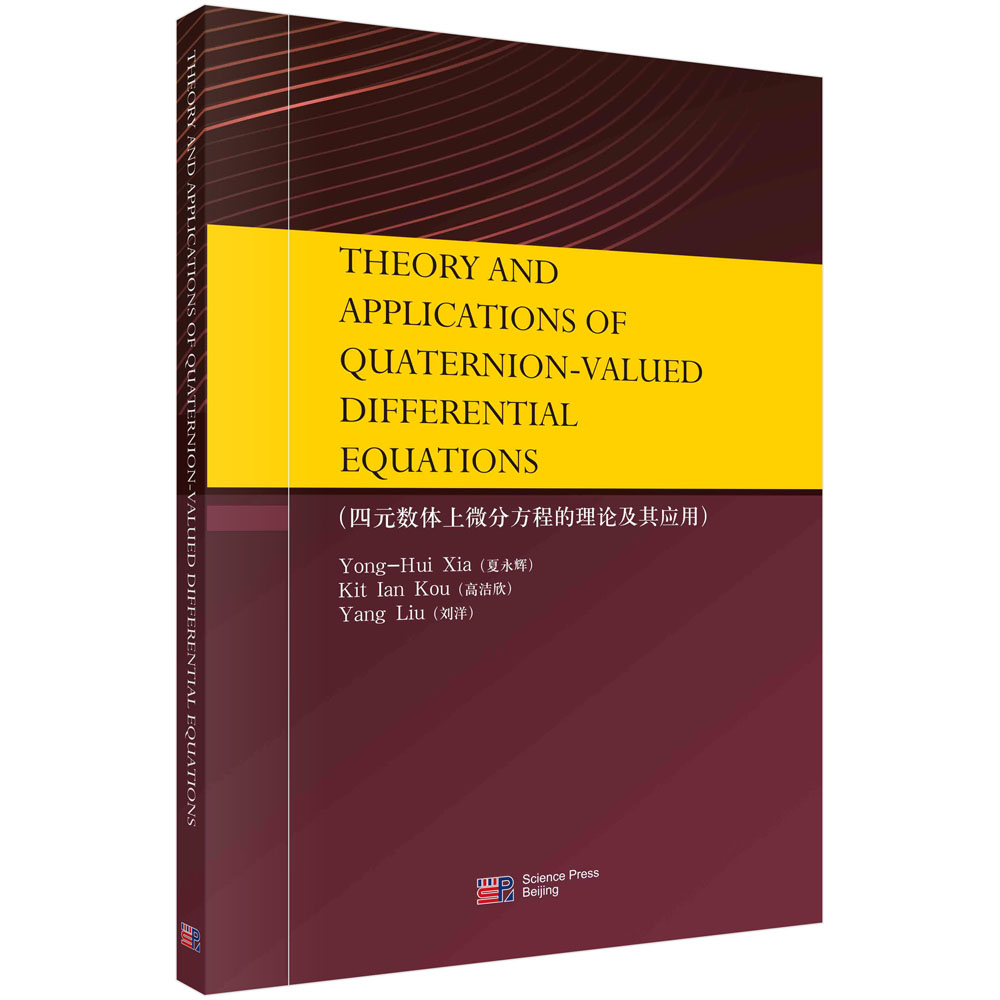
出版社: 科学
原售价: 138.00
折扣价: 109.10
折扣购买: 四元数体上微分方程的理论及其应用(英文版)
ISBN: 9787030690562

Chapter 1 Background of Quaternion and Quaternion-valued Differential Equations
First of all, why should we study the quaternion-valued differential equations (QDEs)? In the following, we will introduce the background and motivations of the quaternion-valued differential equations?
1.1 Background for quaternions
Quaternions are 4-vectors whose multiplication rules are governed by a simple noncommutative division algebra. We denote the quaternion q = (q0, q1, q2, q3)T ∈ R4
where q0, q1, q2, q3 are real numbers and i, j, k satisfy the multiplication table formed
Throughout this book, we use the notations i, j, k to denote the imaginary units. The concept was originally invented by Hamilton in 1843 that extends the complex numbers to four-dimensional space.
Quaternions have shown advantages over real-valued vectors in physics and engineering applications for their powerful modeling of rotation and orientation. Orientation can be defined as a set of parameters that relates the angular position of a frame to another reference frame. There are numerous methods for describing this relationship. Some are easier to visualize than the others. Each has some kind of limitations. Among them, Euler angles and quaternions are commonly used. We give an example from [21, 22] for illustration. Attitude and Heading Sensors (AHS) from CH robotics can provide orientation information using both Euler angles and quaternions. Compared to quaternions, Euler angles are simple and intuitive (see Figures 1.1.1—1.1.4). The complete rotation matrix for moving from the inertial frame to the body frame is given by the multiplication of three matrix taking the
form
where RBV2 (.),RV2 V1 (θ),RV1 I (ψ) are the rotation matrix moving from vehicle-2 frame to the body frame, vehicle-1 frame to vehicle-2 frame, inertial frame to vehicle-1 frame, respectively.
Figure 1.1.1 Inertial frame
Figure 1.1.2 Vehicle-1 frame
On the other hand, Euler angles are limited by a phenomenon called “Gimbal Lock”. The cause of such phenomenon is that when the pitch angle is 90 degrees (see Figure 1.1.5). An orientation sensor that uses Euler angles will always fail to produce reliable estimates when the pitch angle approaches 90 degrees. This is a serious shortcoming of Euler angles and can only be solved by switching to a different representation method. Quaternions provide an alternative measurement technique that does not suffer from Gimbal Lock. Therefore, all CH Robotics attitude sensors use quaternions so that the output is always valid even when Euler Angles are not.
Figure 1.1.3 Vehicle-2 frame
Figure 1.1.4 Body frame
The attitude quaternion estimated by CH Robotics orientation sensors encodes rotation from the “inertial frame” to the sensor “body frame”. The inertial frame is an Earth-fixed coordinate frame defined so that the x-axis points north, the y-axis points east, and the z-axis points down as shown in Figure 1.1.1. The sensor bodyframe is a coordinate frame that remains aligned with the sensor at all times. Unlike Euler angle estimation, only the body frame and the inertial frame are needed when quaternions are used for estimation.
Let the vector q = (q0, q1, q2, q3)T be defined as the unit-vector quaternion encoding rotation from the inertial frame to the body frame of the sensor, where T is the vector transpose operator. The elements q1, q2, and q3 are the “vector part” of the quaternion, and can be thought of as a vector about which rotation should be performed. The element q0 is the “scalar part” that specifies the amount of rotation that should be performed about the vector part. Specifically, if θ is the angle of rotation and the vector e = (ex, ey, ez) is a unit vector representing the axis of rotation, then the quaternion elements are defined as
Figure 1.1.5 Gimbal Lock
In fact, Euler’s theorem states that given two coordinate systems, there is one invariant axis (namely, Euler axis), along which measurements are the same in both coordinate systems. Euler’s theorem also shows that it is possible to move from one coordinate system to the other through one rotation θ about that invariant axis. Quaternionic representation of the attitude is based on Euler’s theorem. Given a unit vector e = (ex, ey, ez) along the Euler axis, the quaternion is defined to be
Besides the attitude orientation, quaternions have been widely applied to study life science, physics and engineering. For instances, an interesting application is the description of protein structure (see Figure 1.1.6) [23], neural networks [24], spatial rigid body transformation [25], Frenet frames in differential geometry, fluid mechanics, quantum mechanics, and so on.
Figure 1.1.6 The transformation that sends one peptide plane to the next is a screw motion
1.2 Background for QDEs
1.2.1 Quaternion Frenet frames in differential geometry
The differential geometr